





PHOTO GALLERY

Photos by Len Blumin
1. American Black Oystercatchers
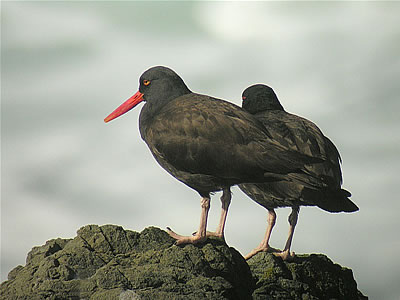
Oystercatchers are big loud shorebirds with red bills and pink feet. That's about all you need to know, and you will see them in coastal areas around the world if the dollar ever regains some of its value. There are ten Oystercatcher species worldwide, all in the genus Haematopus. Many are very similar in appearance, and are given species status largely based on the fact that they have been genetically isolated (some on islands) for long periods of time. Since they tend to be non-migratory, regional differences have evolved.
Our western Black Oystercatcher, aka American Black Oystercatcher, is one of five similar black oystercatcher species. Our American Oystercatcher (H. palliatus) is black above and white below, and one of the five "pied" Oystercatchers. It's really much simpler that I just made it sound. Black back, big red bill, pink feet = Oystercatcher.
They prefer rocky coastlines, where they use that amazing bill to pry shellfish and other prey from the rocks, and then chisel the shells open. Bill looks to fat to pry open a shell, but its "laterally compressed", so it is really rather thin if you could see it from the front, so it can enter a bivalve's shell and sever the muscle. Neat trick. Boring details below.
If you want to look up current taxonomic details, a good source is AviBase: http://www.bsc-eoc.org/avibase/avibase.jsp. Here I learned that among the ten species currently recognized, there are many common names some of which are confusing , so I'll just list one common name for each.
Black/dark Oystercatchers: H. Moquini (African Oystercatcher), H. bachmani (American Black Oys.), H. ater (Blackish Oys.), H. meadewaldoi (Canary Islands Oystercatcher), H. unicolor (New Zealand Oystercatcher).
Black and white ("pied") Oystercatchers: H. palliatus (American Oystercatcher), H. longirostris (Australian Pied Oys.), H. chathamensis (Chatham Islands Oys.), H. Ostralegus (several subspecies and common names, such as Palearctic Oys.), H. leucopodus (Magellanic Oys.).
2. Common Moorhen
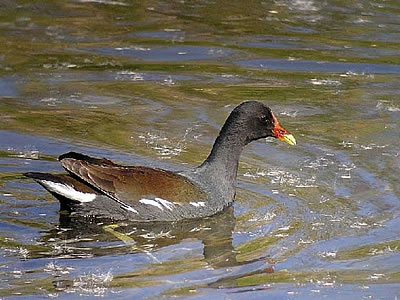
Kenn Kaufman (Lives of North American Birds) writes: "In courtship, male chases female on land; both stop, bow deeply, preen each others feathers." Sounds like a reasonable first date.
In America the Common Moorhen (Gallinula chloropus) was called the Common Gallinule, or Florida Gallinule, until about 1983 when we adopted the English common name for this worldwide species. They are cousins of the American Coot, but are not as widely distributed here, and tend to prefer fresh water marshes and ponds with good cover along the edges, where they often forage or hide. Thus harder to spot, like most Rallids (taxonomy below, per usual).
The Common Moorhen pumps its head back and forth as it swims, kind of like a kid's pull-toy. Feeds on a variety of foods, including sedge seeds floating on the surface, as here at Shollenberger Park is the slough along the northeast side. They have been documented to breed in Marin at various locations (Shuford), but not commonly. Moorhens much more common in eastern half of U.S., especially southeast. Populations stable, and are benefiting in some areas from wetland restorations.
I liked this shot for the way it shows the delicate olive-browns of the back, and the forward head movement. Note the red "shield" extending up the forehead, as well as the broad white band that represents the lateral tail undercoverts.
Taxonomy
Order: Gruiformes (Rails, Coots, Gallinules,Moorhens, Cranes, Limpkin, etc.)
Family: Rallidae (Rails, Coots, Gallinules, Moorhens). 143 species in 34 genera. Only 9 sp. in U.S.!
Genus: Gallinula (Moorhens and Native-hens) - It means "little chicken", which it vaguely resembles. Domestic chickens are of course descended from fowl in the order Galliformes, and are thus not closely related. There are 10 species of Gallinula, 8 named "Moorhen" and 2 named "Native-hen". The other seven Moorhens are largely geographically isolated: Samoan, San Cristobal, Tristan, Gough, Dusky, Lesser, and Spot-flanked. The Native-hens are the Black-tailed and Tasmanian.
Species: Gallinula chloropus (literally "Green-footed gallinule"). Legs and feet more yellow than green, perhaps more so in our subspecies, which is G. c. cachinnans. There are 12 subspecies of the Common Moorhen worldwide (see Birds of North America for details).
3. A Special Gull - (trust me on this one)
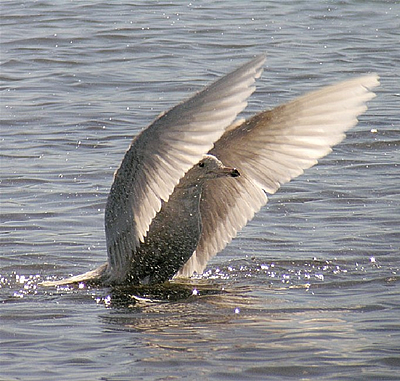
There are gulls, and then there are GULLS!
Thanks to Rich Stallcup and Lisa Hug, I have been (very) slowly learning to appreciate the sometimes subtle characteristics and field marks that distinguish one gull species from another. It can be tedious, but then you find a creature like this and you begin to see why the gull world is more than just gray and white. The Glaucous Gull is one of those birds worthy of a Zumie "Wow!". The juvenile (first winter) Glaucous Gull (Larus hyperboreus) has a very distinctive long pink bill with a black tip, white wing-tips, and overall white/light gray plumage. Difficult to capture all the beauty of this beast, but the back-lighting emphasizes the ghostly translucency of the wings.
Glaucous Gulls are rather uncommon here, preferring to winter more northward, but they have wandered to just about every state at one time or another. Young birds are more often to show up as vagrants. A full adult Glaucous Gull in the Bay area would be quite a find.
We did consider whether this bird might be a hybrid Glaucous x Glaucous-winged Gull, but the striking bill and totally white wing-tips convinced us otherwise. Seen with Don Reinberg, Ron Storey, and others, who all favored 1st winter Glaucous as the I.D.
4. Small bird's worst nightmare
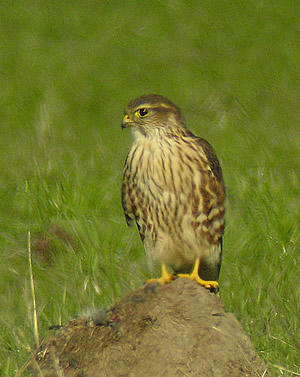
As we searched the plowed fields of Robinson Road looking for Mountain Plovers, Patti spied a raptor on the ground and we screeched to a halt. The bird was perched above its prey on a small mound of dirt, and proceeded to dine voraciously on the unfortunate victim. Scope views were needed to ID the killer, which proved to be a Merlin!
The bill may be on the small side, but this is nothing dainty about this fearsome little falcon. Merlin is just a tad larger than an American Kestrel, but is considerably stronger and heavier, allowing it to take larger prey, which is this case was probably a Western Meadowlark. I'm guessing that this individual is an adult female, perhaps Taiga race, but my experience is limited. When we are lucky enough to spot this phantom creature it is usually here and gone before you can say "boo". Sorry for the soft photo, but distance was considerable, and I figured a blurry Merlin is better than none. Check out the weak mustachial strip, white superciliary line and the fine streaking of the breast. Prairie Falcon would have more white behind the eye and stronger mustache stripe.
5. Yellow-billed Magpie
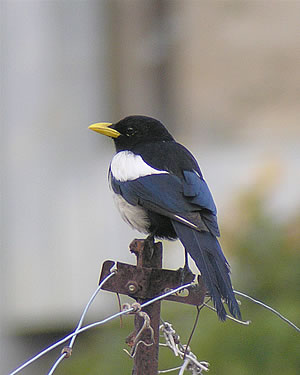
The cover of Jules Evens and Ian Tait's marvelous "Introduction to California Birdlife" features Tait's photo of the Yellow-billed Magpie (Pica Nutalli). Fitting that a volume that presents the vast diversity of California's birds as a function of bio-regional distribution has one of the two true California endemic species on the cover (the other is the Island Scrub Jay). By the way, I was late in discovering this gem of a book, and you should promise yourself to make it the next book to add you your natural history library, no matter where you live.
Wednesday past we were treated to a marvelous trip along Mines Road and Del Porto Canyon, led by Leslie Flint. At Murietta's Well Winery (now owned by Wente Bros.) we say a good number of Yellow-billed Magpies, some of them obviously nesting nearby. We discussed the threat of West Nile Virus (WNV), but no one had specific information. A quick search turned up a worrisome article in the Sacramento Bee (http://www.sacbee.com/378/story/840247.html) which suggests that while Corvids in general are very susceptible to WNV, the Yellow-billed Magpie shows almost no resistance (poor antibody response), and local declines in the Sacramento Valley may have reached 90%! How very sad. Tragic to lose any bird, but this beautiful creature is one of our treasures, sought by birders from around the country and the world who travel here to see it. Mines Road, with a goodly amount of oak savannah habitat, features what seem to be still healthy numbers of Magpies.
The blue color often seen on the Yellow-billed Magpie is iridescence, so lighting and angle will make the appearance vary. The shot above is good for color, but foreshortens the Magpie's magnificent long tail. Magpies eat a lot of large insects, and like crows and ravens will partake of carrion and other foods, including grains and acorns. West Nile Virus is clearly the Mapgie's greatest threat, but secondary poisoning by such events as ill-advised poisoning of ground squirrels can also take its toll, not to mention of the loss of oak woodlands to development and agriculture in the central valley.
Not so cheerfully, Len.
6. Myiarchus Flycatcher
Along Faye Road near the Kern River Preserve (east of Bakersfield, California) we found a large flycatcher on an exposed branch, allowing us a good chance to study the field marks, despite harsh back-light. You may want to take a look and decide for yourself before reading about the I.D. below. Photos are of the same bird from two different angles.
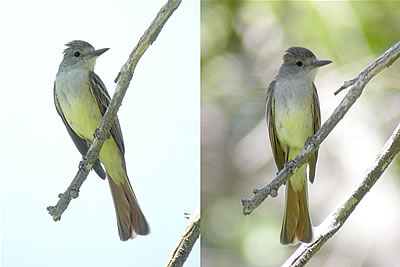
Big cresty gray birds with pale yellow bellies belong to the genus Myiarchus, in the sub-family Tyranninae along with the Kingbirds, Great Kiskadee and Sulfur-bellied Flycatcher. The sub-family is referred to as the Tyrannine Flycatchers, or Tyrannids. There are three other sub-families that help make the large New World family of Tyrant Flycatchers, or Tyrannidae. (See Clark's account in Sibley Guide).
Anyway, just as the Empidonax Flycatchers present ID challenges, so does the Myiarchus group, comprised of some 20+ species [Clements/Avibase]. Fortunately, our task is simplified by "map and calendar" (Mark Pretti's phrase rings in my ears still).
Many of the Myiarchus species are found either on islands (Puerto Rico, Lesser Antilles, Grenada, Galapagos, etc.) or in Central/South America. Only five species are found in the U.S., including La Sagra's Flycatcher which is occasionally seen in southern Florida. That leaves us with four possibilities.
Ash-throated Flycatcher is our default I.D., as we heard it frequently on our trip and it is by far the most common Myiarchus in the West. The Ash-throated FC has a pale yellow belly, and dark tips of the tail feathers form a dark band at the end of the tail so that the rufous color does not reach the end.
Dusky-capped FC seldom seen here, and it has paler wing bars and less rufous on the under-tail, along with a smaller bill.
We saw the Great-crested FC in Florida, a bird seen extensively in the East but only rarely in the west. The Great-crested has perhaps more yellow on the belly than seen here. So Great-crested very unlikely.
That leaves us with Brown-crested Flycatcher as our best choice. Note the large bill, fairly bright yellow belly, and rufous on the tail extending to the tip, all favoring Brown-crested over Ash-throated. This bird didn't vocalize, so no help there. Disputations, elucidations and corrections are welcomed.
[Added later]
I often learn more from being wrong than right, and my recent Myiarchus photo is no exception. Early feedback supported both Brown-crested and Ash-throated about equally. The photos were forwarded to some experts who chimed in as follows (thanks to those who forwarded to the mavens):
Alvaro Jamarillo (via Leslie Flint): "This bird looks like an Ash-throated to me based on the thin bill, and the tail pattern (dark terminal bar cutting off rufous from the tail tip)."
Jon Dunn (via Lynne Ehlers, thru Terry Colburn): "I heard back from Jon - he said the photo was an Ash-throated Flycatcher, a very yellow one!"
Clearly I placed too much emphasis on the yellow belly, and I just don't have enough experience with relative bill size/shape to be a reliable judge. Unfortunately the photos are rather inclusive on the best ID feature of all, that of the color of the distal undertail as to the presence or absence of a dark band.
7. Mountain Chickadee
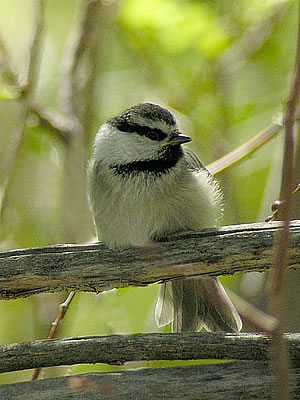
Landers Meadow is a rather special place along the Piute Mountain Road in the southernmost portion of the Sequoia National Forest. The wildflowers and butterflies made the visit special, and this juvenile Mountain Chickadee (Poecile gambeli) added further charm to our visit. (Must admit that I did use PSE to "remove" a branch that crossed in front diagonally from lower right(see tail) to upper left. Bird almost totally backlit, which helps preserve detail in the white areas. The Mountain Chickadee is a bird of the western mountains, from Canada down to where we were in Kern County, and a bit further south in New Mexico and Arizona. Easily distinguished from other chickadees by the white stripe above the eye (superciliary). Close relative of the Black-capped Chickadee (Poecile atricapilla) which barely makes it to northernmost California.
8. Broad-billed Hummingbird on nest
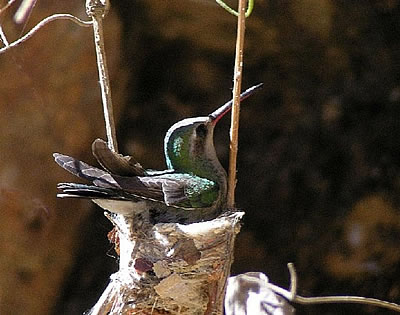
9. Broad-billed Hummingbird
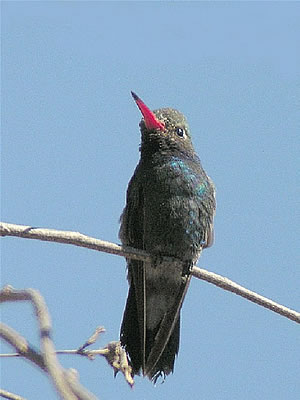
10. California Quail, male, profile portrait
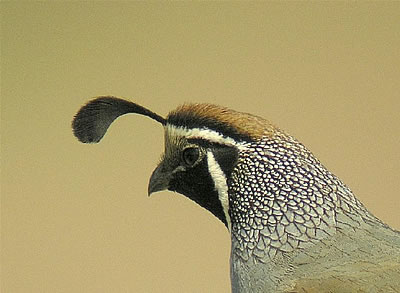
11. A Different Hawk - powder blue no less!
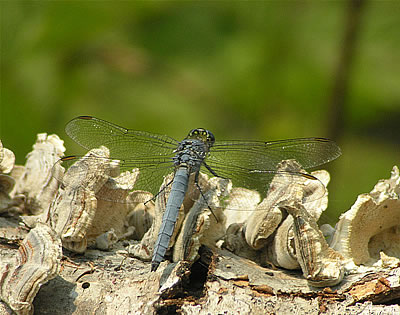
The Western Pondhawk (Erythemis collocata) is indeed a predator, but of the dragonfly sort. The male seen here is a beautiful soft blue, while the female is light green. We saw many of them on a Rich Stallcup walk around Five Brooks recently. Photo taken through scope at a distance of about 16'. Wingspan only 2.5", but looked larger to me. The log was being recycled by Turkey Tail fungi (perhaps Trametes versicolor)
TOWHEE.NET: Harry Fuller, 820 NW 19th Street, McMinnville, OR 97128
website@towhee.net